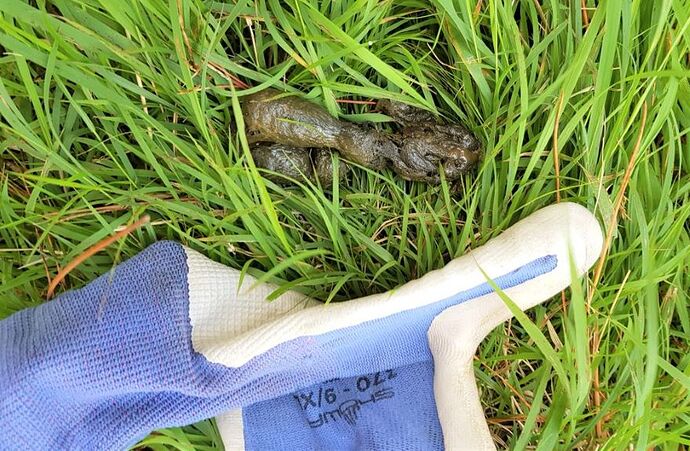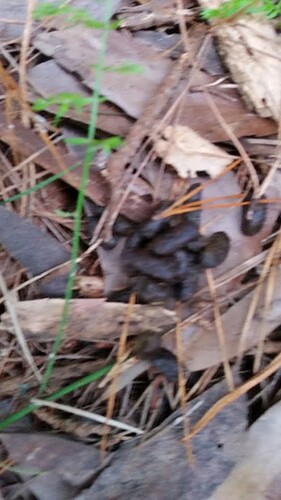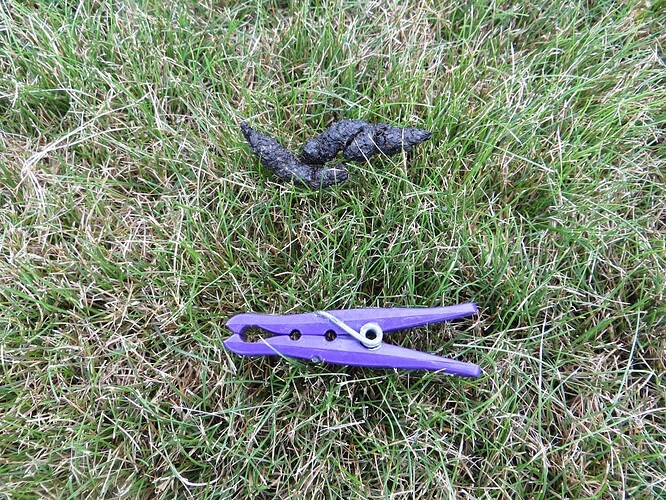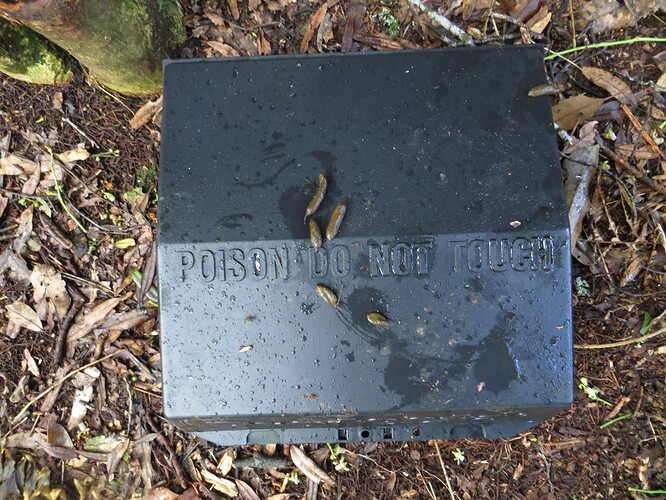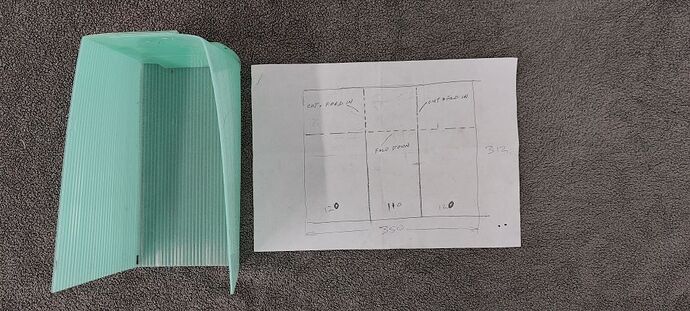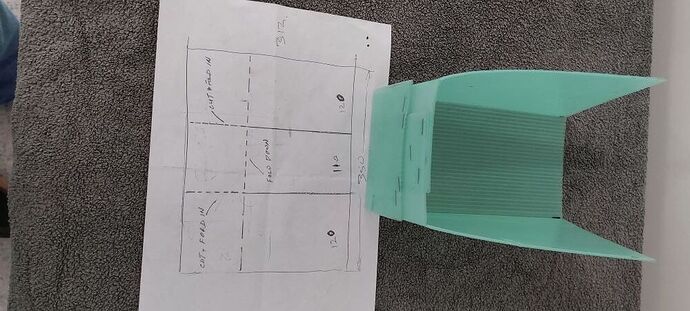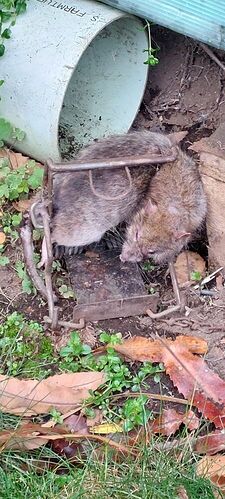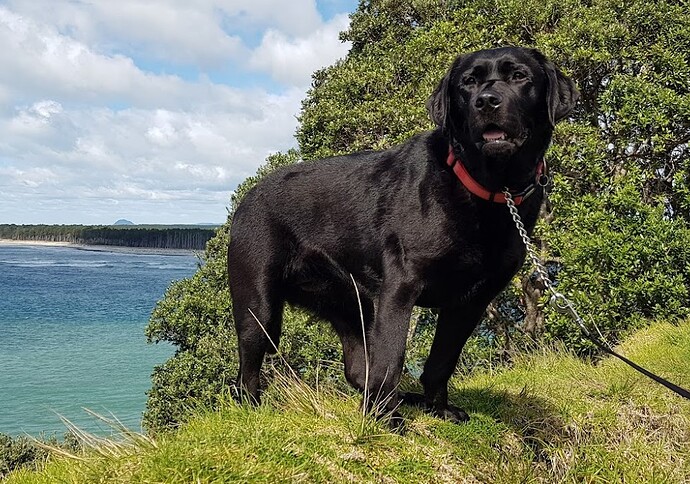Great to hear from you WFW – I have found that GN chocolate lure has not been as effective as other lures - today we have switched about 40 rat traps from GN possum paste to GN meat lovers – it will be interesting to see if there is any response. Rat numbers are low - today we found six traps tripped – but no victims – one had its coreflute cover ripped of the tree so maybe a large animal involved.
Great that your T Rex traps are working well for you - trap design and plastics evolve – they no doubt improve if they get reports of breakages or soft catches. A few years ago, I did a season on a line at Puketoki Reserve – they use walk through boxes with a central T Rex trap so animals enter the trap from either side. I had a chat to the Puketoki controller today and he tells me that traps rarely break, and wounded animals are few – so this matches your experience.
While working in the Park today, I met a lady who was having problems with rats on a lifestyle block – traps in a shed and under the house not killing rats – T Rex! – so she took a picture of the spare Kness Snap-E I carry in my pack.
The picture below is of a walk through box with a central Gorilla trap – difficult to place the trap while set and the last bump often tripped it – black nails so I dislike Gorillas intensely! The Trex is much easier to place and works well. Also a picture of the cover ripped off a trap today – I like open covers.
Let me know if I am boring people.
Keen to be involved. I’ve noticed too that one bait someone raves over in a bush block or farmland is useless in sub alpine so if the study could include type of landscape plus altitude please that would make it even more useful.
With a whole sachet of the chocolate and nut lures, I trapped maybe 10 rats. The Meat Lovers’ lure is one of my go-to lures, because I’ve had such good results with it.
Goodnature’s Cinnamon Possum lure has actually trapped a decent number of rats - I’d say its trapping rate is 5x better than the chocolate and nut lures, so it’s worth a try, IMO. I use it 3-4 times a year as a “curiosity lure”, to pique the interest of rats that might be bored with what’s normally on offer. I was surprised to find that it was a successful lure for a pair of weasels that I trapped within the same week in December.
It would be interesting to find out how the chocolate lure performs in habitats occupied by humans vs the wild. If rats have already eaten chocolate out of somebody’s garbage, I think that they are likely to develop a taste for it. Under those circumstances, the chocolate lure could be way more attractive to rats, mimicking a delicacy.
I prefer the T-Rex over other snap-traps for a number of reasons. I don’t only use the T-Rex, though, because I’ve had way better results since I started using a variety of traps. If I only used DOC tunnels or snap-traps, my rat kills would drop by about 50%. I think that the reason why using multiple models is effective (for me, at least), is that rats that become really good at eating the bait out of a T-Rex, might not be as good at eating out of a Kness/Gorilla, for example. If a rat’s able to eat the lures out of the T-Rex and Kness/Gorilla without getting killed, it might slip up when it encounters a Victor Pro.
Often when inexperienced trappers are having difficulty killing rats, the trap(s) aren’t to blame. Was the T-Rex in a tunnel or was it sitting on the ground? Was it sited properly? Was she using good lures? Was she checking the trap frequently?
Switching to a Kness won’t make any difference if she doesn’t learn to use her traps properly. Your advice should turn her T-Rex into a killing machine (if she didn’t get rid of it, that is).
I, too, have ended up with purple fingers for a while after accidentally setting traps off.
The T-Rex is the worst of the lot, because the teeth add skin injuries to the bruises. My fingers can definitely tell which trap is the strongest and has the best grip.
Recently, I ordered a pair of snap-trap double-sets for Gorilla traps. TR’s don’t work in the tunnels, unfortunately, but Kness and Gorilla traps are held in place.
Alert 365 - Double Rat Trap Tunnel | Connovation NZ
DOC double-sets have much higher trapping rates than single-sets, so I’m interested to find out if snap-trap double-sets also perform better than single-sets.
The main reason why I bought them, is that there are some good sites that it would be difficult to get DOC double-sets to and I doubt that I would be able to get them to sit on the ground evenly, because there are a lot of rocks and exposed roots to deal with. The 365’s will go almost anywhere.
If you can find it, I highly recommend trying tallow in your traps. Just be careful using it, because some bird species are fans of the stuff.
You aren’t boring me! I wouldn’t reply to your posts if I wasn’t interested in what you have to write. The more that trappers communicate with each other, the better our collective results will be, in my opinion.
Knock 'em dead, Mindie!
Cheers.
Hi Dan. If you don’t like the idea of carrying a firearm around, even an air rifle, they can get heavy if you’re carrying them all day. I use a lance ( a 20cm stiletto blade attached to the end of a converted golf putter) it even doubles as a walking pole. It will dispatch any animal you live capture. I use a forked stick behind the shoulders or neck to hold the animal still while you say goodbye.
Cats, hedgehogs and rats – they all leave a trail behind them. Some have a large home range but its often worth putting out a cage or a trap. I had a few “neighborhood
” hogs around my 1-acre garden - a magpie trap worked well, and I cleaned out 20 in a few months. At least hogs are on the PFBOP hit list.
I really like Kness Big Snap E’s as well. Pity they’re not NAWAC tested.
Where do you get those green tunnels?
Hi David – I have yet to use a better trap than the Kness Snap-e rat trap.
I am currently in the process of taking down my green tunnels from logs, branches, roots etc and repositioning traps in new housings on the ground beside our trapping tracks. Sadly, creeping asparagus is taking over our environment and covering many of the places where we have attached traps. I think that even rats may struggle to find our trap tunnels up on logs covered with asparagus.
Our support partner has agreed to upgrade many of our old traps, Doc250s, Timms, and the green ground mounted walk through tunnels. They have provided us with the Connovation run through bait stations that house Snap-IT rat traps. Run Through | Rodent Bait Station | Connovation Ltd.
The Snap-IT trap looks very similar to the Kness Snap-e trap and either trap will fit snugly into the run through bait station. I don’t like the concept of a side entry rat trap and would prefer a front entry system that we have used for many years with wood tunnels or my coreflute tunnels – but I guess time will tell. I am picking that there will be a lot of shoulder clamps where the kill could be inhumane.
I made the green coreflute tunnels from left over orchard use coreflute sheets. But other coreflute products such as Real estate signage might do.
I will be removing a lot of the green tunnels as I place the new walk through bait stations on the ground beside our tracks – they may need a new home somewhere – but they are well used and some are rat chewed.
I have attached dimensions of the tunnels – this is my current model to suit front entry Snap-e traps. A screw in the rear of the coreflute attaches it to a log or wood base so it can be lifted to service the trap.
I have used many different types of animal kill traps over the years – trapping is a “gruesome” business and you will likely find that even NAWAC approved traps can produce wounded animals or ugly kill results.
I concur, Mindie. Snap traps should be positioned head-on, so that predators are hit on the neck, with the full force of the trap striking them.
I do, however, have 2 T-Rexes aligned to the side, which have to be positioned that way in order for an experimental tunnel to work. In between 2 T-Rexes is a mousetrap to lure in scavengers. This has been an effective way to kill small predators, especially female weasels. I’ve limited predators’ access to the traps, so that they can only be hit by the front half of the trap, which delivers the most force. I do think that the T-Rexes’ teeth will reduce the odds of inhumane kills occurring, compared to smooth kill-bars. All of the kills have looked clean to me, with straight bodies, instead of ones in awkward positions, which suggest a lot of thrashing around as they died.
It’s a shame that the support partner hadn’t consulted you beforehand. Is it too late to let them know that the new tunnels are less humane than the tunnels you’ve been using? That might be the best way to make them reconsider their purchase(s).
A really big problem with the light, plastic run-through tunnels, is that it can be difficult to keep them stable. Predators dislike tunnels that are unstable, and they’d be very easy for people to steal. I have 2 of Connovation’s D-Rat Supervisor Max (they’re pricey, but they’re good). I’ve mounted them on scraps of 4x2, which gives them a lot of stability. The one in the bush has rocks on both sides of it, so it’s firmly in place.
Something that might work, would be to put some gravel at the entrances as an anchor.
The Snap-It is the same basic model as a Kness. The Connovation version has a setting bar, which helps a lot, and a sensitivity setting, which is a great way to control mouse numbers, when they’re interfering too much. Trapping mice with a traditional Kness was very rare for me, and a lot of rats were able to eat out of them, without firing the trap.
Regarding trap testing, I’ve had more dirty kills with my DOC traps than my snap traps! The humaneness of traps has as much to do with who is operating them as their design, in my opinion.
Cheers.
Great to read your posts WFW – your practical experience and knowledge is outstanding
Just to cover a few issues –
We replaced 20 open coreflute tunnels with 20 run-though tunnels fitted with Snap-IT traps and the same meat lovers lure and after two weeks we got one mouse – so I cant yet compare front on strikes to side on strikes. We have used 200mm ground staples to lock the tunnels down on clear dirt locations
I recovered and cleaned all the old Kness Snap-e traps- amazing how much unpleasant stuff that accumulates in six-year-old traps – 25% failed a foot plate self-raise test so were biffed
I have removed 5 eight year old doc250 traps and replaced them with four new Connovation doc250s. stripped the old boxes, ground out all accessible rust, CRC rust killed, CRC zinc painted, new mesh, reassembled and they are ready for a new life – but with far less power. Treated timber trap boxes are not kind to galvanised steel traps – rust was severe
Still getting a few big Norways in our garden tunnels – the rusty old Fenn6s just sit waiting for the next rodent to step on the foot plate
Two old Victor pros down the side track are still clocking up the numbers – often in twos and threes, one recent sequence was masses of blood on the Victor but no body - next a stunned old fella bleed out resting on the rear mesh – I left him on top of the box – next day I got his mate with a good head shot – and they keep on coming up from the estuary about 100m away
A sorry place around home at present – Mindie, my Lab trapping companion is ten days into a 12 week recovery period following a TTA Cruciate surgery – cage restriction so far except for toilet duties and living with a neck cone. Back to the surgeon tomorrow – a very expensive process.
I took a bad fall on wet ground a couple of months back and did the splits – finally took a trip to the Physio today and he confirms it is a serious hip flexor tear – so I have to rebuild the muscle again which might take 12 weeks – so just an easy trap line today.
I will be buying some M&Ms tomorrow.
You’ve sure been up to a lot since your last message.
I think that DOC traps would be better for run-through tunnels than snap traps, due to the width of the treadles. Mice are probably scurrying over the Snap-It traps so quickly that they aren’t putting enough pressure on the treadles to spring the traps. Are you aiming to trap both mice and larger predators?
If a trapper knows what they’re doing, 6-year-old traps should be absolutely filthy. I use a scraper and a firm toothbrush to give my snap and DOC traps a clean when they need it. I only clean traps to the point that they function, though, because the more a trap smells like other predators and the traces of lures that have been used, the better.
The exception to the rule is moldy traps, because when you add a fresh lure, it can be colonized very quickly. That’s why I only use mold-resistant lures in wet weather - tallow, Goodnature lures, and solid lures like chickpeas and M&M’s, which usually take a few weeks to go moldy (if they aren’t nibbled away by then).
I only buy stainless steel traps now, because I’ve had to retire some galvanized traps that still had good springs, but were badly rusted. I’d rather pay the difference than have 1 more thing to worry about.
I’ve given most of my tunnels thorough cleanings at some point and then modified them - adding ramps, changing the dimensions of the primary and secondary baffles with high quality mesh, using holes in plywood as entrances, adding mousetraps, etc. The downside to cleaning tunnels is that they lose a lot of the natural scents left behind by predators. Following the advice of an experienced trapper that I know, I leave my tunnels way dirtier than I did when I started trapping.
I cringe at the thought of doing the splits, under any circumstances, let alone on wet ground. When there’s been a decent rain here, I wait until things dry up a bit before I check my traps on steep terrain.
I hope that you manage to recover on schedule and with minimal pain and discomfort. While you’re recovering, adding a few more snap trap tunnels to the ones that you’re still checking, might pay off. Clearly, you’ve found some very good sites. It might be a good opportunity to do some lure experiments, too. The M&M’s first, of course.
Short, daily walks to your Victors is a good, low-impact way to prevent your muscles from atrophying, and to get some vitamin D. Continuing to trap rats while you’re healing, should also lift your spirits.
I’m also dealing with a hip problem, a repetitive strain injury called bursitis. I’d been moving, splitting and stacking a lot of firewood over a few days, bending over too many times on my right side. I don’t feel any pain when I sit down, but it hurts when I walk, stand up, or lie down. Getting to sleep has been challenging, to say the least. The weather has been excellent, of course, so it’s very frustrating to be stuck inside. I’m still checking my traps close to home, intercepting some of the re-invaders.
I’m sorry to hear about your dog’s injury - and the vet bills.
Our family’s first dog was Chesapeake Retriever, a form of Labrador, that Mindie resembles.
Our present dog, Libby, is no spring chicken, so she might have 5 years or so left. She’s a natural hunter, killing possums, pigs, rats, rabbits, goats, and cats. She came within inches of a large stoat, but it darted into a dense colony of blackberries and escaped. Occasionally, she’ll bring me a hedgehog as a gift. The sight of a large hedgehog in a dog’s mouth, akin to a squirrel with its mouth full of acorns, is a very amusing sight. Why didn’t I take a photo?!
Cheers.


